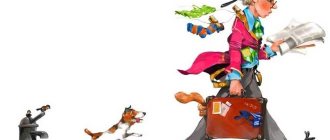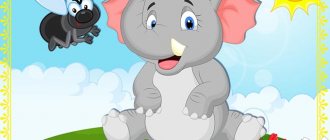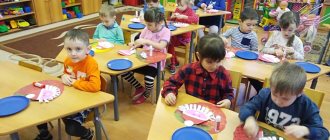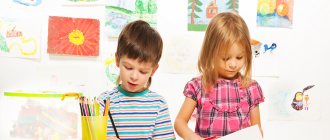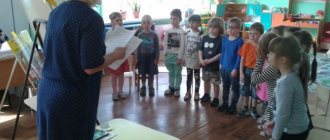Calendar and thematic planning for the week in the middle group “Clothes, shoes, hats”
Anastasia Cheremnykh
Calendar and thematic planning for the week in the middle group “Clothes, shoes, hats”
Topic of the week: Clothes, shoes, hats.
Goal: To expand children’s understanding of things: clothes, shoes, hats and their purpose. Give initial ideas about fabric and its properties.
Final event: exhibition of children's works.
Monday 4 November
I half
day
Group Morning exercises Complex No. 1. Compiling descriptive stories “Our Clothes”. Goal: to enrich children’s understanding of the purpose of clothing, to remember the names of its parts and material.
D/I “Name the clothes” Purpose: To introduce children to the types of clothes, shoes and hats, to connect clothes with the seasons. Develop children's active speech and enrich their vocabulary.
Individual D/I “Draw the missing details”
OD in sensitive moments Situational conversation “What are we having for breakfast today?” Goal: to attract children's attention to food, to form children's understanding of the benefits of breakfast.
Free activity of pupils Independent activity of children in activity centers
Organization of the subject-spatial environment Introduce a thematic album for consideration “Clothes, shoes, hats” Goal: to activate children’s speech, to clarify and generalize words on the topic.
OD 1. Familiarization with fiction. Reading the fairy tale “The Tale of Irishka’s Clothes” Purpose: to introduce children to a new fairy tale, teach them to express their opinions about the actions of the heroes.
2. Physical development according to the plan of the physical education worker.
Group walk Observation of the work of the janitor. Goal: to develop a willingness to help, the ability to evaluate the results of work, cultivate respect for working people, develop speech, increase vocabulary (the name and purpose of the janitor’s work equipment).
P/I “Cucumber - cucumber” Goal: strengthen the leg muscles, develop a sense of rhythm.
Individual D/I “Count” Goal: agreement of the numeral with the noun “one beautiful dress, one white T-shirt.”
OD in sensitive moments “Let’s hang up wet gloves to dry” Goal: continue to develop self-service skills in children, teach children to carry out individual assignments in accordance with instructions.
Free activity of pupils Independent play activities of children with external material.
Organization of the subject-spatial environment Create conditions for games, taking into account the interests of children, form positive behavioral habits and moral qualities in joint play.
II half of the day Group Gradual awakening. Health-improving gymnastics after sleep. Verbal game “One - Many” Purpose: to learn to form nouns denoting items of clothing in the plural.
Individual D/I “Name the color” Purpose: to identify the level of children’s assimilation of sensory standards.
OD in sensitive moments Labor assignment: “We wash doll clothes” Goal: to develop in children the ability to wash small items of doll clothing, to encourage the desire to finish the job.
Free activity of pupils Role-playing game “Let’s iron the laundry” Goal: to expand children’s ideas about caring for and caring for dolls’ clothes. Encourage independent attempts to select attributes and organize the game environment.
Organization of subject-spatial environment Games with large and small building materials. Goal: to teach children to use the skills they have mastered to implement various plans and build durable buildings.
Group walk Observation of crow behavior. Goal: continue to familiarize children with seasonal changes in the life of birds.
Sedentary game “Shirt” Purpose: to encourage children to pronounce the text in accordance with the movements, to activate the names of clothing parts in speech.
Individual Game exercise “The bird is jumping” Purpose: to practice jumping on your toes.
OD in sensitive moments Labor activity: cleaning the kindergarten site from garbage. Goal: to form a responsible attitude towards the task, to encourage initiative in helping each other.
Free activity of pupils Independent play activities of children with external material.
Organization of the subject-spatial environment Create conditions for games, taking into account the interests of children, form positive behavioral habits and moral qualities in joint play.
Evening Group D/I “Find by description”
Goal: to consolidate children's knowledge about winter and summer and winter clothes.
Individual Offer cards with drawn objects, count them and place the same number next to them.
OD in sensitive moments Continue to improve food culture and use cutlery correctly.
Free activity of pupils Independent activity of children in activity centers
Organization of the subject-spatial environment Place “Clothing” stencils in the art corner
Tuesday 5 November
I half of the day Group Morning exercises. Complex No. 1. Looking at pictures on the topic “Shoes”. Conversation “What kind of shoes are there?” Goal: to deepen children’s understanding of the concept of “Shoes”.
Tasks: Clarify the name and purpose of the shoes. Learn to group shoes based on season. D/I “Put it on the shelves” Purpose: to practice classifying items of clothing, shoes and hats.
Individual D/I “From small to large” Purpose: to learn to lay out a sequence of different sizes from smallest to largest, from left to right.
OD in sensitive moments Practical exercise for the formation of cultural and hygienic skills “Wash, wash, clean, clean.”
Free activity of pupils Independent activity of children in activity centers.
Organization of the subject-spatial environment Laying out books on the topic “Shoes”. Adding coloring pages “Summer shoes, winter shoes, demi-season shoes.”
OD Application “Decoration of clothes for a doll” Objectives: to teach children to cut a circle out of a square. Lay out the finished shapes on paper. Reinforce the techniques of creating a composition and train children in neat gluing and the ability to cut along a curve with scissors.
Walk Group Observation “Trees in late autumn”. Invite children to note similarities and differences between familiar tree species.
P/I “Mousetrap” Purpose: to improve coordination of movements and dexterity, the ability to act after a signal.
Individual Exercise “Speak correctly” Purpose: to encourage children to repeat words after the teacher (names of items of clothing, changing the tempo and volume.
OD in sensitive moments Conversation “Why should we protect nature?” Goal: to continue to teach children to love and protect nature.
Free activity of pupils Independent activity of children with external material.
Organization of the subject-spatial environment Create conditions for games, taking into account the interests of children, form positive behavioral habits and moral qualities in joint play.
II half of the day Group Gradual awakening, health-improving gymnastics after sleep. Reading S. Prokofiev’s “The Tale of the Shoes” Goal: to develop the ability to listen carefully, to develop an interest in reading.
Individual Individual work on movement development. Strengthening the ability to throw the ball to each other.
OD in sensitive moments Situational conversation “Dress according to the weather” Goal: to activate and supplement children’s knowledge about the qualities and purpose of clothing, about the choice of clothing in accordance with weather conditions.
Free activity of pupils Competition: “Who can best color the princess’s dress.”
Organization of subject-spatial environment Layout of colored paper, plasticine, cardboard for children's creativity.
Walk Observation “Crust on puddles” Purpose: to draw children’s attention to the ice formed on puddles. Sedentary game “Boots” Purpose: to encourage children to pronounce the text accompanied by movements.
Individual Exercise “Catch and throw”
Goal: to train children in throwing a ball up with both hands and catching it. Develop dexterity and coordination of movements.
OD in sensitive moments Labor assignment: collect toys after games on the site. Cultivate a desire to work, evoke positive emotions from work.
Independent activity of pupils Independent games of children with external material.
Organization of the subject-spatial environment Create conditions for games, taking into account the interests of children, form positive behavioral habits and moral qualities in joint play.
Evening Group Game “Missing Word” Goal: to develop the ability to listen carefully and learn rhyming phrases.
Individual printed board game “Lace up your shoe”
Goal: development of fine motor skills.
OD in sensitive moments Situational conversation “Is it possible to wear summer shoes in winter?”
Independent activity of pupils Independent activity of children in activity centers.
Organization of the subject-spatial environment Contribute to the organization of games with favorite toys, learn to negotiate interactions.
Wednesday 6 November
I half of the day Group Morning exercises. Complex No. 1. Conversation with children on the topic: “Let's talk about hats.” Goal: to consolidate children’s knowledge about hats and their purposes. D/I “The fourth odd one. Clothes, shoes, hats." Goal: to activate children’s vocabulary on the topic, develop mental activity and attention.
Individual D/I “Find the differences” Goal: to develop attention, observation, logical thinking.
OA in sensitive moments Situational conversation “Why do you need to be able to give in?” Goal: to teach children to avoid quarrels, give in and negotiate with each other.
Free activity of pupils Board and printed games: lotto, cut-out pictures, puzzles, inserts, educational games “Dress the doll”.
Organization of the subject-spatial environment Introduce plot pictures on the topic. Goal: development of speech, enrichment of ideas about objects in the immediate environment.
OD 1. Familiarization with the world around us “How clothes appeared” Purpose: To clarify and consolidate children’s ideas about the purpose and functions of clothing necessary for human life.
Tasks:
• Introduce children to the history of clothing.
• Teach children to navigate the past of clothing, to establish a connection between the material and the way items of clothing are used.
• To instill in children the desire to convey the beauty of fabric in drawings.
2. Physical development according to the plan of the physical education worker.
Group walk Observation of the wind. Goal: to concretize and consolidate children’s knowledge about wind. Use a literary word.
D/I “What wind?” Goal: to teach how to select a relative adjective.
Individual Exercise: jump into a circle and jump out of a circle.
OD in special moments Continue to work on strengthening the habit of helping peers in children.
Independent activity of pupils Independent games of children with external material.
Organization of the subject-spatial environment Create conditions for games, taking into account the interests of children, form positive behavioral habits and moral qualities in joint play.
II half of the day Group Gradual awakening, health-improving gymnastics after sleep.
Reading the fairy tale “Sister Alyonushka and Brother Ivanushka” Goal: to develop listening skills, develop interest in reading.
Individual D/I “Missing word” Objectives: to develop the ability to listen carefully and learn to rhyme phrases.
Od in sensitive moments Situational conversation “How to make peace” Goal: to develop social and communication skills in children.
Independent activity of pupils Role-playing game “Animal Breeders” Objectives: to develop children’s social and communication skills, the ability to negotiate, agree to play, distribute roles.
Organization of subject-spatial environment Coloring pages, attributes for role-playing games.
Group walk Bird watching. Goal: to continue to instill in children a love and respect for nature.
P/I “Birds in Nests”
Goal: development of dexterity.
Individual P/I “Run from me. Run to me." Goal: to develop spatial orientation.
Od in sensitive moments Labor activity: sweeping garbage from benches. Goal: to develop labor skills.
Independent activity of pupils Independent games of children with external material.
Organization of subject-spatial environment Contribute to the organization of games with favorite toys, learn to negotiate interaction.
Evening Group Game Situation “Adventure on the Bus”.
Objectives: continue to familiarize children with the rules of conduct on transport.
Individual D/I “Guess what we’re up to?” Objectives: to teach children to identify the essential features of objects. Develop coherent speech.
Od in special moments Work in the corner of the book: together with the teacher, glue the covers of the books.
Objectives: to introduce the folk saying “A book is a source of knowledge.”
Independent activity of pupils Work in the sensory education corner.
Objectives: teach children to examine objects, determine their various properties using different senses.
Organization of subject-spatial environment Manual labor: making fun toys.
Objectives: learn to cut out funny toys according to a template, use the ability to work with paper and cardboard.
Thursday 7 November
I half of the day Group Morning exercises. Complex No. 1. View illustrations accompanied by the teacher’s story “Who Sews Clothes.” Goal: to introduce children to the profession of a seamstress and the items necessary for work.
D/I “One – many.” Goal: to activate children’s vocabulary on the topic, develop mental activity and attention.
Individual D/I “Name what color.” Goal: to consolidate knowledge of primary colors and their shades.
OD in special moments Work in a corner of nature. Caring for indoor plants. Goal: introduce children to a new way of keeping plants clean (cleaning leaves with a dry brush).
Free activity of pupils Observe how children handle toys, who should be reprimanded, explain why, and cultivate a caring attitude towards toys.
Organization of the subject-spatial environment Offer children coloring pages depicting various headdresses for independent coloring. Goal: to develop coordination, motor skills, perception.
OD
1. HER Music according to the plan of the music worker.
2. HER Drawing “My Hat” Goal: to develop the ability to draw straight and wavy lines, to consolidate skills in working with paint and a brush. Tasks:
Educational:
1. Consolidating children’s knowledge about hats.
2. Development of children's ideas about the arrangement of elements on the cap (vertically, horizontally, obliquely) and decoration with straight, wavy lines, dots, circles.
Educational:
1. Development of fine motor skills of hands, thinking, attention.
2. Consolidation of skills in working with paint and brush.
Educational:
1. Fostering a positive emotional attitude towards visual activity and the results of one’s work.
Group walk Observation of pigeons. Objectives: continue to consolidate knowledge about the bird world, clarify what they eat and where birds live, how people care for them. P/I “Homeless Hare” Purpose: To develop in children of middle preschool age the ability to navigate in space and run quickly.
Individual D/I “Mittens and Gloves” Goal: to form children’s ideas about how mittens differ from gloves, to promote speech development.
OD in sensitive moments Labor activity: collecting twigs for crafts. Introduce children to the rules of collecting natural materials and cultivate a positive attitude towards work.
Independent activity of pupils Independent games of children with external material.
Organization of the subject-spatial environment Create conditions for games, taking into account the interests of children, form positive behavioral habits and moral qualities in joint play.
II half of the day Group Guessing riddles on the topics “Clothes, shoes, hats” Goal: to develop logical thinking. Plot role-playing game “Clothing Store” Purpose: To consolidate children’s knowledge of the general concept of “shop”; develop the ability to perform several interrelated actions in the game. The ability to develop in children the ability to interact and get along in joint play, to instill a sense of teamwork.
Individual D/I “divide into groups” Goal: to develop children’s ability to group pictures according to the purpose of the objects depicted on them, to use generalizing concepts in speech (clothes, shoes, etc., to develop thinking and vocabulary.
OD in sensitive moments Situational conversation on the topic: “Dressing ourselves” Goal: to remind children of the sequence of dressing and undressing, to cultivate independence.
Independent activity of pupils Independent activity of children in activity centers.
Organization of the subject-spatial environment Samples of different types of fabric for viewing and examination. A hanger with clothes for organizing a role-playing game. Purpose: to promote the emergence and development of a role-playing game.
Group walk Examination of houses and buildings.
Goal: to teach children to see the variety of houses in height, width, color, number of storeys, purpose, to identify the number of floors of the house, to compare them in height and size.
Individual D/I “Tell me about your clothes” Goal: to develop the ability to describe objects.
OD in sensitive moments Cleaning toys and sports equipment after games. To foster independence in children, to teach them order and neatness, to encourage the desire to complete the work they have started, to teach them to talk about the results of their work.
Independent activity of pupils Independent games of children with external material.
Organization of the subject-spatial environment Contribute to the organization of games with favorite toys, learn to negotiate interactions.
Evening Group Reading of K. Chukovsky’s poem “The Miracle of a Tree.”
Tasks: continue to cultivate interest in fiction, introduce the work, pay attention to the illustrations, and expand vocabulary.
Individual D/I “Name it correctly” Goal: to learn to name items of clothing correctly.
OD in sensitive moments Work activity: cleaning toys before going home. Goal: to cultivate a positive attitude towards work, responsibility when carrying out assignments.
Independent activity of pupils Games - dressing up “Dressing up for Katya’s doll’s birthday” Goal: to stimulate interest in using theatrical elements in the game, to develop coherent speech and artistic abilities.
Organization of subject-spatial environment Layout of colored paper, plasticine, cardboard for children's creative activities.
Friday 8 November
I half of the day Group Morning exercises. Complex No. 1 Conversation: “Classification of clothing: winter, summer, demi-season. Finger game "Clothes"
D/I “Count and name” Purpose: to practice agreeing numerals with nouns.
Individual D/I “Assignment” Goal: orientation in space.
OD in regime moments Conversation: “When should you wash your hands?”
GOAL: Formation of ideas about the hygienic fundamentals of life safety.
TASKS:
— Improve children’s understanding of the importance of hygiene procedures (hand washing).
— Develop the ability to independently notice the need for hand washing.
— Instill the need to lead a healthy lifestyle.
Independent activity of pupils Independent games of children in activity centers.
Organization of the subject-spatial environment Replenish the corner of the role-playing game “Atelier”. A new set of clothes for a boy doll.
Goal: to promote the emergence of a role-playing game and the development of the game plot.
OD
1. FEMP “Clothing Store” Purpose: to consolidate knowledge about the number 2; consolidate the ability to count within 5, ordinal counting up to 5; consolidate knowledge of primary colors and geometric shapes; consolidate names about geometric shapes (circle, triangle, square); develop memory, speech, logical thinking, imagination; cultivate independence, the ability to understand the educational task; cultivate the ability to come to the rescue, friendly relationships; to develop the ability to listen carefully to the teacher and correctly complete tasks, to correlate the number of objects with the number.
2. Physical development according to the plan of the physical education worker.
Group walk Observing the sky in autumn. Goal: to develop observation skills and coherent speech. P/I “Find your color” Purpose: to train children in running and spatial orientation using color modules.
Individual Game exercise “When does this happen?” Goal: to clarify and expand children’s understanding of the seasons, their signs and sequence;
expand your vocabulary and practice coherent speech;
develop observation, interest in the surrounding nature, activity, attentiveness, and reasoning skills.
cultivate the ability to listen carefully to the stories of your comrades and complement the answers.
One in routine moments Draw children’s attention to the fact that things from the locker need to be taken out and put away sequentially, and not all at once.
Independent activity of pupils Independent activity of children on a walk.
Organization of the subject-spatial environment Create conditions for games, taking into account the interests of children, form positive behavioral habits and moral qualities in joint play.
II half of the day Group Discussion “How to take care of your clothes” Goal: continue to learn how to dry and clean your clothes, wash, and wipe your shoes.
Articulatory gymnastics “Clothing” goal: perform actions and movements in accordance with the content of the poem.
Individual D/I “Boy and Girl” Goal: to consolidate children’s knowledge about items of clothing and their purpose.
OD in sensitive moments Situational conversation about accuracy.
Independent activity of pupils Contribute to the organization of games with their favorite toys.
Organization of subject-spatial environment Exhibition of books. Looking at illustrations. To introduce children to the works of S. Marshak, to arouse interest in creativity.
Group walk Observation of passers-by. Goal: Identify seasonal clothing. Fix the name of the clothing and the material from which it is made.
P/I “Traps” Purpose: to train children in running without bumping into each other. Individual Individual motor activity - standing long jump.
Od in sensitive moments Practical exercise “Dress yourself” Purpose: to remind children of the sequence of dressing and undressing, to cultivate independence.
Independent activity of pupils Independent games of children with external material.
Organization of the subject-spatial environment Contribute to the organization of games with favorite toys, learn to negotiate interactions.
Evening Group Role-playing game with magnetic dolls “Demonstration of children's clothing” Purpose: to develop in children the ability to construct new and varied game plots, to consolidate the ability to distribute roles; consolidate the ability to prepare the necessary conditions for the game; contribute to the enrichment of the game with new solutions (participation of an adult in the game, changes in attributes, the course of the game); promote the ability to conduct dialogue in a story game; develop communication skills and cultivate friendly relationships.
Individual Exercise “Imitation of animals based on a fairy tale”
Goal: to develop plastic movements.
Od in sensitive moments Situational conversation “Why does a person need shoes?”
Goal: Expand and activate vocabulary on the topic. Learn to correctly name the parts of shoes. Develop attention, thinking, fine motor skills.
Independent activity of pupils Looking at fashion magazines. “Who invented clothes?”, “Who sews?”
Organization of subject-spatial environment Games with tabletop and printed material.
OD summary on speech development on the topic: Autumn clothes, shoes. Senior group
OD summary on the development of the lexical-grammatical structure of speech and coherent speech in the senior group “Autumn clothes, shoes and hats”
Goal: development of the lexical-grammatical structure of speech and coherent speech of preschool children. Tasks: 1. Activation of the dictionary on the topic of clothing, shoes, hats. 2. Exercise in the formation of the category of the genitive case, constructions with the preposition C. 3. Mastering the verbal dictionary on the topic being studied, the verb “put on.” 4. Develop fine and gross motor skills, attention, memory. 5. Practice writing a descriptive story. 6. Develop the ability to listen to the answers of your comrades without interrupting. Equipment: subject pictures depicting hats, clothes, shoes.
Progress of the lesson
Speech therapist: Hello, children. Please tell me what time of year it is now? Children: Autumn. Speech therapist: Correct! What changes in nature occur in autumn? Children: The leaves turn yellow and fall, it becomes cold, the wind blows and it rains. Speech therapist: Well done! Speech therapist: What things should you wear in the fall? Children: Jacket, hat, trousers, boots... Speech therapist: Yes, you said everything correctly. Children, you probably guessed what we will talk about today in class. Children: Yes. Speech therapist: That's right, guys. Today we will talk about clothes, shoes and hats. Speech therapist: Guys, how can you call a jacket, scarf, sweater in one word? Children: Clothes. Speech therapist: How can you call a cap, hat, beret in one word? Children: Hats. Speech therapist: Guys, how can you call boots, boots, shoes in one word? Children: Shoes Speech therapist: Well done, children. You see how much clothing, hats, and shoes you know. Speech therapist: Please tell me, if we wear clothes in the fall, what are they? Children: These clothes are called autumn. Speech therapist: Well done, right. Speech therapist: Guys, now we’re going to play a game called “What should we wear for a walk?” Look, you have pictures, I will ask a question, and you must answer. Speech therapist: What will you wear, and what will Tanya wear? Child: I will wear a shirt, and Tanya will wear a dress. Speech therapist: What will you wear, and what will Vova wear? Child: I’ll wear a sweater, and Vova will wear trousers. Child: I’ll wear a dress, and the girl will wear a sundress. Child: I’ll wear shoes, and the boy will wear a T-shirt. Speech therapist: Well done, guys. Let's play the game “Choose a Word” with you. We will select adjectives for the words: dress (which?), coat (which?), jacket (which?), sweater (which?), boots (which?). Children: The dress is elegant, red, new, beautiful... . The coat is warm, autumn, brown... The jacket is comfortable, autumn, warm, bright... . Knitted woolen sweater, yellow, comfortable... . Leather boots, comfortable, black... . Speech therapist: Okay, well done. Now let’s play the game “Say the opposite”, I say the word, and you say the opposite. Speech therapist: Put on Children: Take off Speech therapist: Put on shoes Children: Take off shoes Speech therapist: Buy Children: Sell Speech therapist: Tie up Children: Untie. (fasten - unfasten, iron - wrinkle, hang - take off, put on shoes - take off shoes). Speech therapist: Children, please tell me what can be done with clothes. Children: Clothes can be put on, worn, taken off, sold, bought, sewed, knitted, dressed, buttoned, ironed, darned, mended, patched, washed, dried, hung. Speech therapist: Well done! Guys, what elements or details of clothing, shoes, and hats do you know? Children: A detail of clothing is a pocket (collar, cuff, button, eyelet, fastener, button, belt, zipper, trouser leg, sole, heel, strap, brim. Speech therapist: Okay, you know a lot of details of clothing, shoes and hats. Look on your pictures and name the items of shoes and clothing, and also list the details of the named things. Child: I have a shirt with a collar. Child: I have a skirt with a belt. Child: I have a scarf with tassels. Child: I have shoes with heels. Speech therapist : Well done, children. You coped well with the task. Speech therapist: Let's rest a little. Together we help mom, We rinse the laundry ourselves. One, two, three, four - we stretched, bent over. We did a good job. (We repeat the movements after the speech therapist) Speech therapist: A little rested, sat down nicely in our seats, keeping our backs straight. Speech therapist: And now, guys, we will write a story - a description about a shirt, dress, coat, boots. According to plan: What is it? When are they worn? What are the clothes made of? Parts of clothing? Speech therapist: Please tell me what we talked about in class? Children: We talked about shoes, clothes and hats. Speech therapist: Right, what else did you do during the lesson? Children: Named details of clothing, performed physical exercises. for a minute, we played the game “Say it the other way around”, choosing words for clothes. Speech therapist: Well done, everyone answered well in class today. The lesson is over. Goodbye.
We recommend watching:
Summary of a lesson on speech development in the senior group on the topic: Autumn Plan - summary of educational activities for preschoolers of the senior group: In the land of fairy tales Summary of educational activities in the senior speech therapy group Summary of OD in the senior group. What kind of grain is this, not just a simple one - golden
Similar articles:
Lesson summary - traveling in kindergarten for the International Day for Older Persons
Entertainment “Visiting Autumn”. Senior group
Project on the theme of the week “World of Fashion” in the middle group
Taimyr municipal budgetary preschool educational institution "Dudinsky Child Development Center - Kindergarten "Snow White", Dudinka city
Project on the theme of the week “World of Fashion”
In the middle group "Daisies"
Educator:
Kovalchuk N.V.
Objective of the project:
Expand and concretize children’s ideas about clothing
,
its purpose, and the details of which it consists.
Project objectives:
To form children’s ideas about clothing, its types, parts of clothing.
Develop children's speech and expand their vocabulary.
Develop color perception, figurative ideas, creativity, imagination, compositional skills, color perception.
Teach children to generalize, classify, systematize.
Teach children to take care of their clothes and develop a caring attitude towards them.
Project type:
group
Project type:
Creative, short-term, collective.
Duration:
short-term, 1 week (09.11-13.11)
Project participants:
children of the secondary group "Romashki", teachers, parents
Final event:
Role-playing game "Clothing Store"
Working with parents:
moving folders, information stand, three question method.
Project implementation stages:
Stage 1.
Selecting a project topic.
Thematic plan for the 2019-2020 academic year.
Selection of methodological literature on the topic of the week.
Selection of material, games - experiments, didactic games.
| Creativity Center Plasticine, crayons, paints, foam rubber, sticks, pictures, stencils, glue, templates, scraps of fabric | Book Center books by B. Grimm, N. Nosov. pictures on the topic of the week. | Experimentation Center Waste material, watering can, containers of various sizes, cups, molds, scraps of various fabrics |
| Construction Center constructor, cubes, mosaic, lego | Subject: "Fashion world" | Game center Attributes for s.zhetno role. games “Clothing Store”, “Family” |
| Cognition Center (board, exhibition) pictures on the theme of the week, fabric scraps | Theater Center Bibabo, house, finger. Theater, screen. | Center of movement Sport. equipment, massage mats, modules, engines, ribbons, flags, steering wheels. |
- by type of children's activity:
| Gaming We play board and printed games “Find a pair”, “Dress the doll”, “Find an object”, “Who is wearing what” puzzles, plot-role-playing games using attributes, | Artistic Reading fairy tales and stories by B. Grimm, N. Nosov | Communicative speech games, looking at pictures |
| Motor Fun games, p/i, games to develop dexterity, eye | Subject: "Fashion world" | Labor We clean the corner of nature, the group, wash the toys, water the flowers, put the toys in their places. |
| Cognitive and research We look at pictures and experiments with fabrics | Productive sculpt, draw, design | Musical Imitation of various sounds, playing musical instruments |
